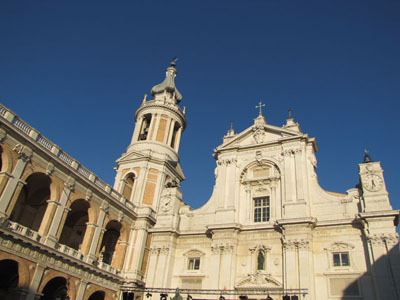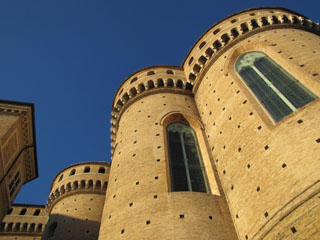Loreto
Distanza dalla riviera: da 6 a 14 km.
Tempo di visita: 3 ore.
LA CITTÀ IN FORMA DI SANTUARIO
 Capitale del culto Mariano, il borgo è famoso nel mondo perché all'interno della sua Basilica conserva il Santuario della Santa Casa.
Capitale del culto Mariano, il borgo è famoso nel mondo perché all'interno della sua Basilica conserva il Santuario della Santa Casa.
COME ARRIVARE
L'itinerario muove dalle spiagge della Riviera verso l'entroterra, sulla via dell'arte e della fede. Onde evitare il traffico del lungomare, è preferibile seguire le strade interne sino a raggiungere la statale adriatica 16, da prendere in direzione Pescara. Il tragitto consente di ammirare la rigogliosa vegetazione del Parco del Conero e il paesaggio alle spalle della costa marchigiana. Si abbandona la statale all'uscita Loreto e si seguono le indicazioni per risalire il colle su cui si erge il borgo. L'autostrada A 14 (uscita Loreto – Porto Recanati) e la statale 77 sono le altre vie principali che collegano Loreto al resto d'Italia.
COSA VISITARE
 Fin da lontano Loreto si mostra come città in forma di Santuario: con bastioni e mura cinquecentesche, nato attorno al santuario della Casa di Nazareth, secondo la tradizione traslata in queste terre dagli angeli nel 1294. Divenuto in poco tempo centro di culto e pellegrinaggio il paese si andò sviluppando soprattutto dal 1469, con la costruzione della basilica-fortezza, voluta per difendere i muri della Santa Casa. Il cuore della città, in cui si concentra il nostro itinerario è piazza della Madonna. Parcheggiata l'auto fuori dalle mura castellane, vi si può accedere da Corso Boccalini, da Via Sisto V oppure da Porta Marina. Abbellita da una seicentesca fontana, la piazza è chiusa a est dall'imponente basilica: l'edificio, fra il tardo gotico e il rinascimentale, richiede un'accurata visita. Al suo interno, proprio sotto la grandiosa cupola, si trova la Santa Casa in cui Maria ricevette l'annunciazione dall'Angelo. Protetta esternamente da un rivestimento marmoreo progettato dal Bramante, conserva al suo interno la Madonnina nera con la tradizionale dalmatica. Al santuario e alla basilica hanno lavorato insigni artisti: Baccio Pontelli, Andrea Sansovino, Giuliano da Sangallo, Luca Signorelli, il Pomarancio, Luigi Vanvitelli, Melozzo da Forlì.
Fin da lontano Loreto si mostra come città in forma di Santuario: con bastioni e mura cinquecentesche, nato attorno al santuario della Casa di Nazareth, secondo la tradizione traslata in queste terre dagli angeli nel 1294. Divenuto in poco tempo centro di culto e pellegrinaggio il paese si andò sviluppando soprattutto dal 1469, con la costruzione della basilica-fortezza, voluta per difendere i muri della Santa Casa. Il cuore della città, in cui si concentra il nostro itinerario è piazza della Madonna. Parcheggiata l'auto fuori dalle mura castellane, vi si può accedere da Corso Boccalini, da Via Sisto V oppure da Porta Marina. Abbellita da una seicentesca fontana, la piazza è chiusa a est dall'imponente basilica: l'edificio, fra il tardo gotico e il rinascimentale, richiede un'accurata visita. Al suo interno, proprio sotto la grandiosa cupola, si trova la Santa Casa in cui Maria ricevette l'annunciazione dall'Angelo. Protetta esternamente da un rivestimento marmoreo progettato dal Bramante, conserva al suo interno la Madonnina nera con la tradizionale dalmatica. Al santuario e alla basilica hanno lavorato insigni artisti: Baccio Pontelli, Andrea Sansovino, Giuliano da Sangallo, Luca Signorelli, il Pomarancio, Luigi Vanvitelli, Melozzo da Forlì.
Si consiglia inoltre di non perdere il Museo-Pinacoteca, che raccoglie otto tele di Lorenzo Lotto, un'importante collezione di ceramiche da farmacia e vari cimeli. Il museo ò ospitato nel Palazzo Apostolico, l'edificio che delimita piazza della Madonna a nord – ovest. La visita della città può proseguire con una passeggiata fra i negozi di Corso Boccalini; meritano infine uno sguardo le absidi da piazzale Loreto e il panorama da piazza Giovanni XXIII.
Natura e Turismo
Guida turistica e naturalistica Franca Silvia Di Cicco
Tel. +39.0717216120, Cell. 339.1313603, E-mail: silviafdicicco@virgilio.it